Bài giảng Kiểm thử phần mềm - Chương 5: JUnit - Nguyễn Thanh Hùng
Các thuật ngữ về JUnit
―Test runner‖ là phần mềm chạy kiểm thử
và báo cáo kết quả
―Test suite‖ là một tập các trường hợp
kiểm thử
―Test case‖ kiểm tra phản ứng của một
hàm đơn với 1 tập đầu vào
―Unit test‖ là một kiểm thử của phần tử
mã nguồn nhỏ nhất có thể kiểm thử,
thường là một lớp đơn.Các thuật ngữ về JUnit
―Test fixture‖ là môi trường chạy kiểm thử. Một môi trường
mới được cài đặt trước mỗi lần thực hiện trường hợp kiểm
thử, và được huỷ bỏ sau đó.
Ví dụ: để thử nghiệm một CSDL, môi trường kiểm thử có thể thiết
lập máy chủ ở trạng thái ban đầu chuẩn, sẵn sàng cho khách hàng
để kết nối.
―Integration test‖ là một kiểm thử cho việc kết hợp hoạt
động của nhiều lớp với nhau
Junit hỗ trợ một phần cho kiểm thử tích hợp

Trang 1
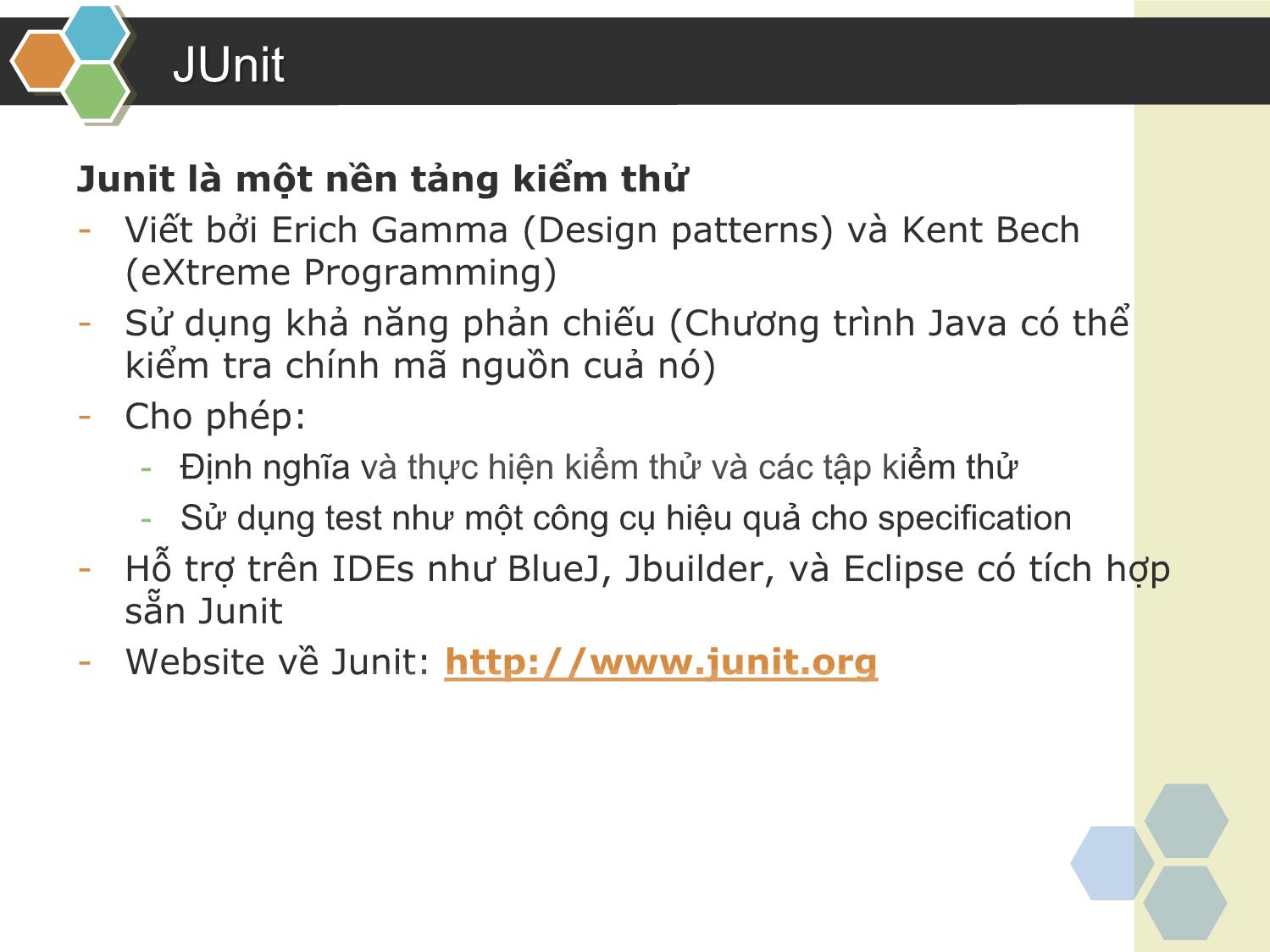
Trang 2
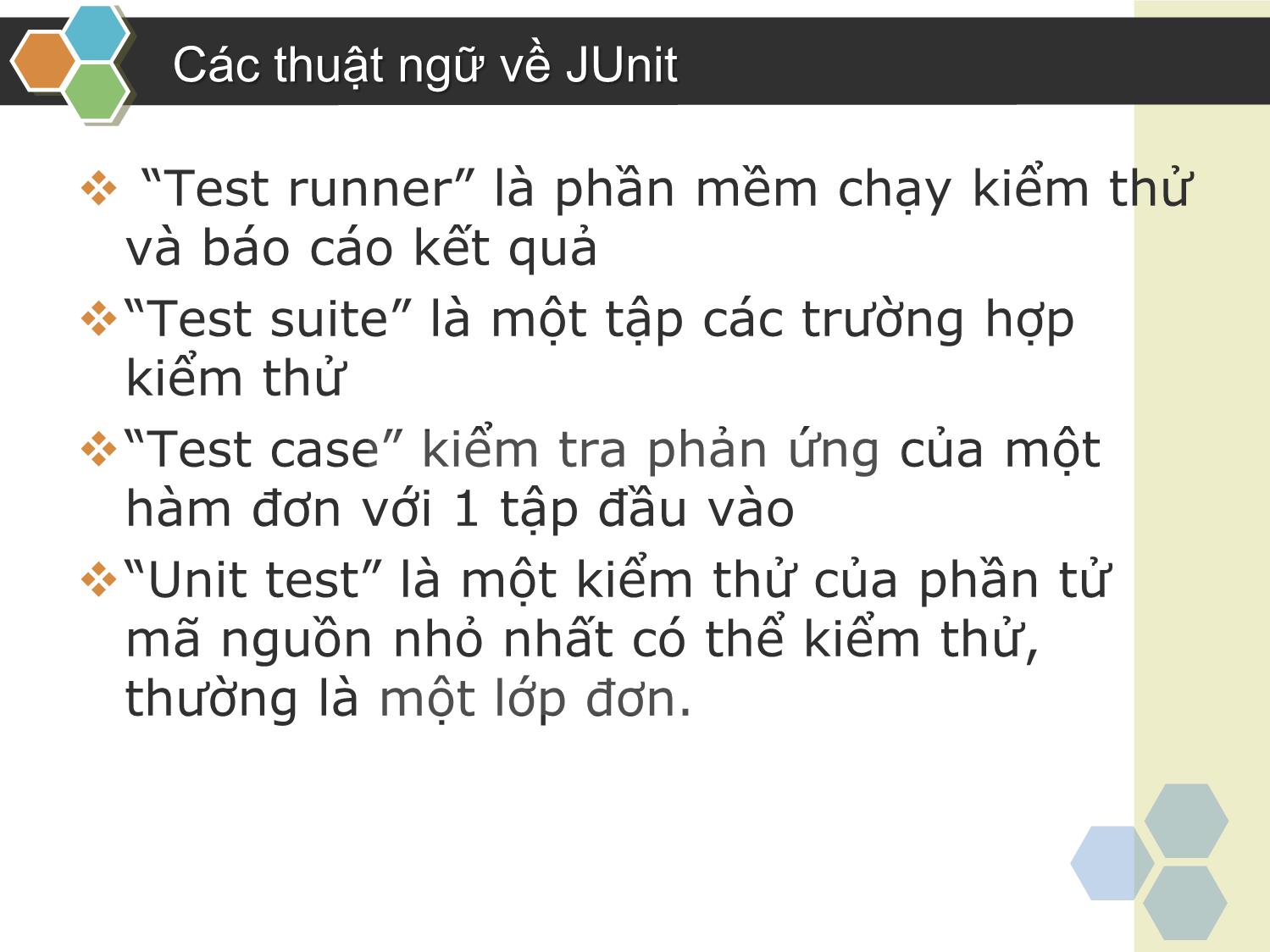
Trang 3
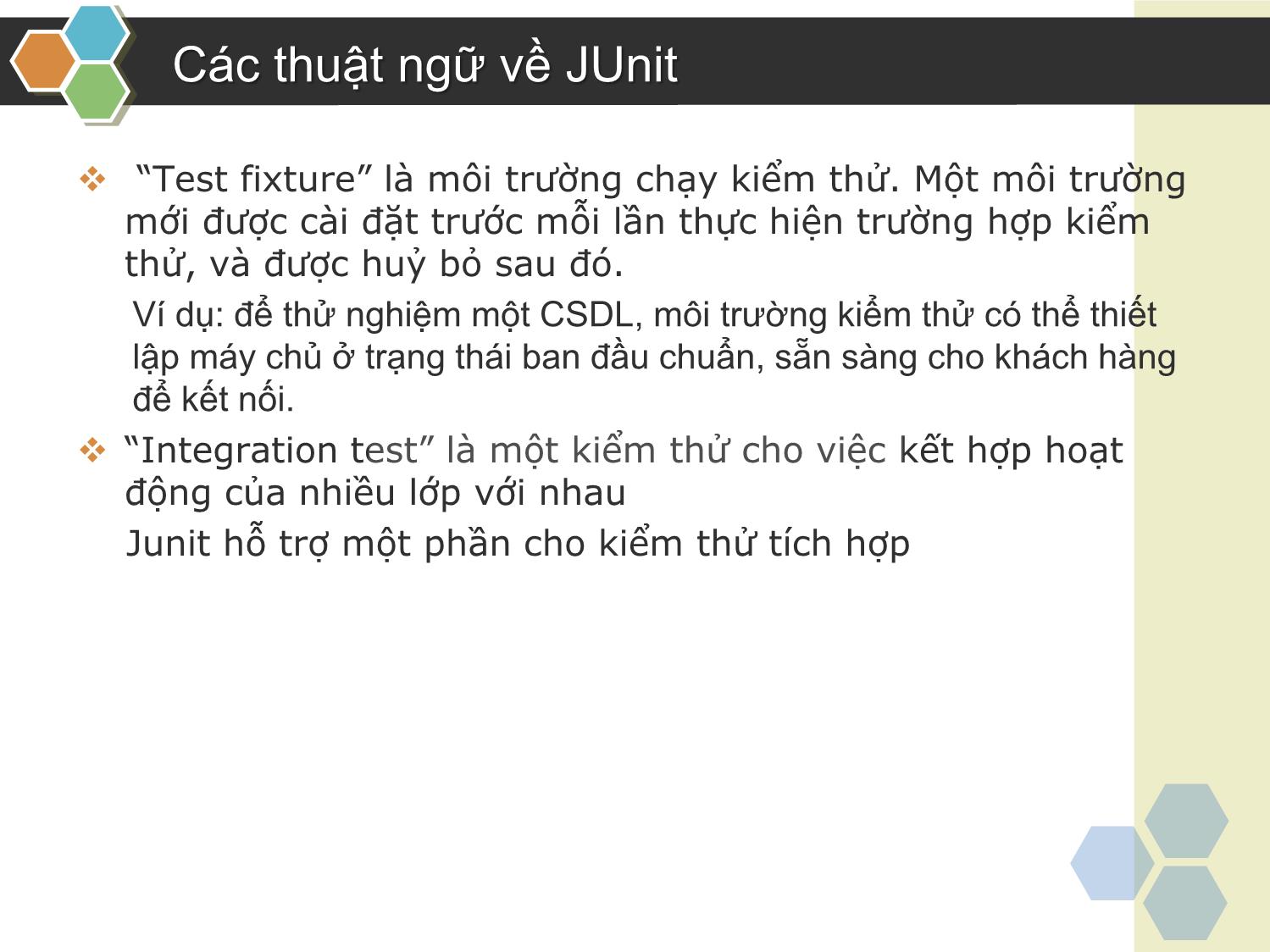
Trang 4
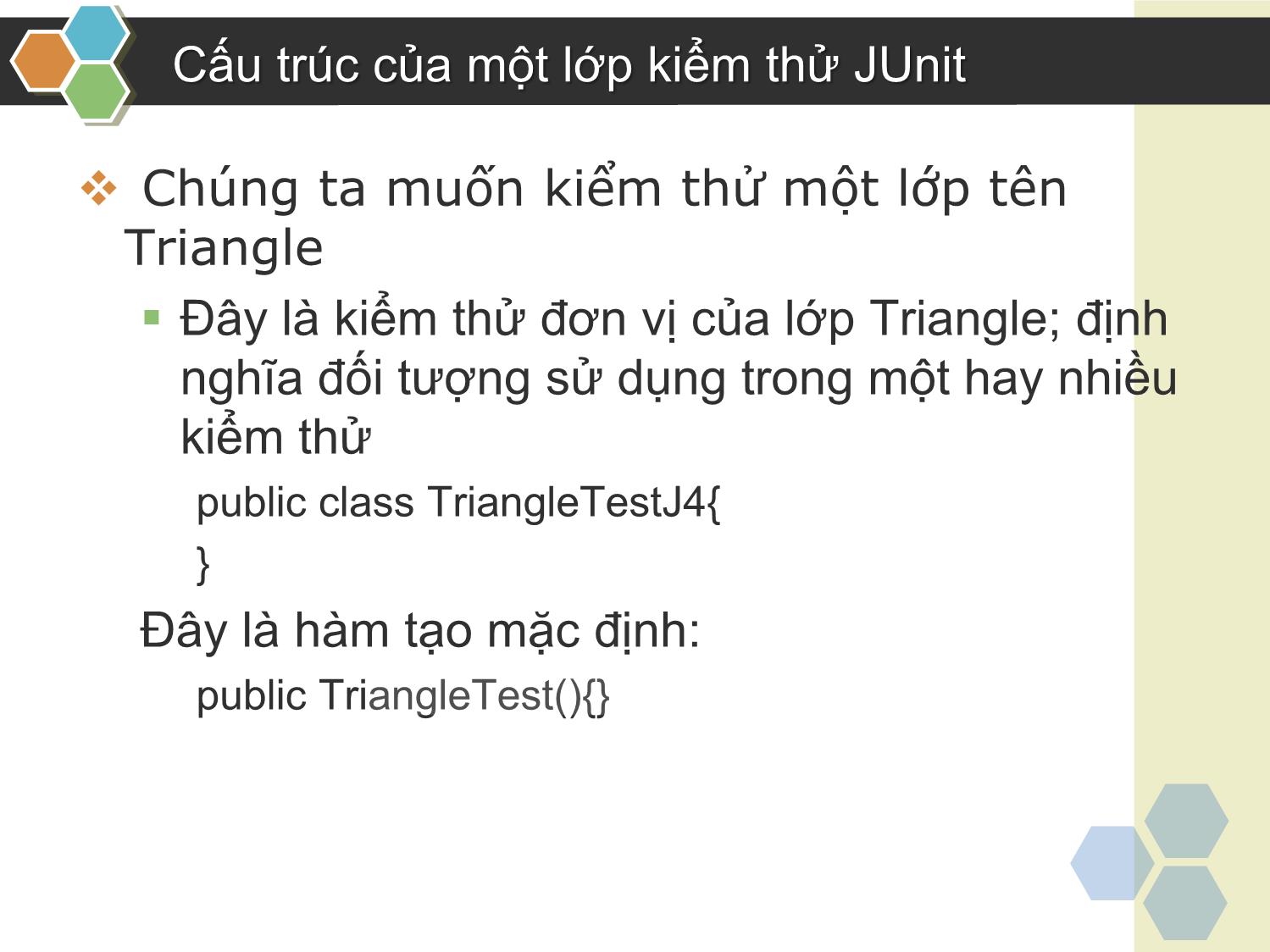
Trang 5
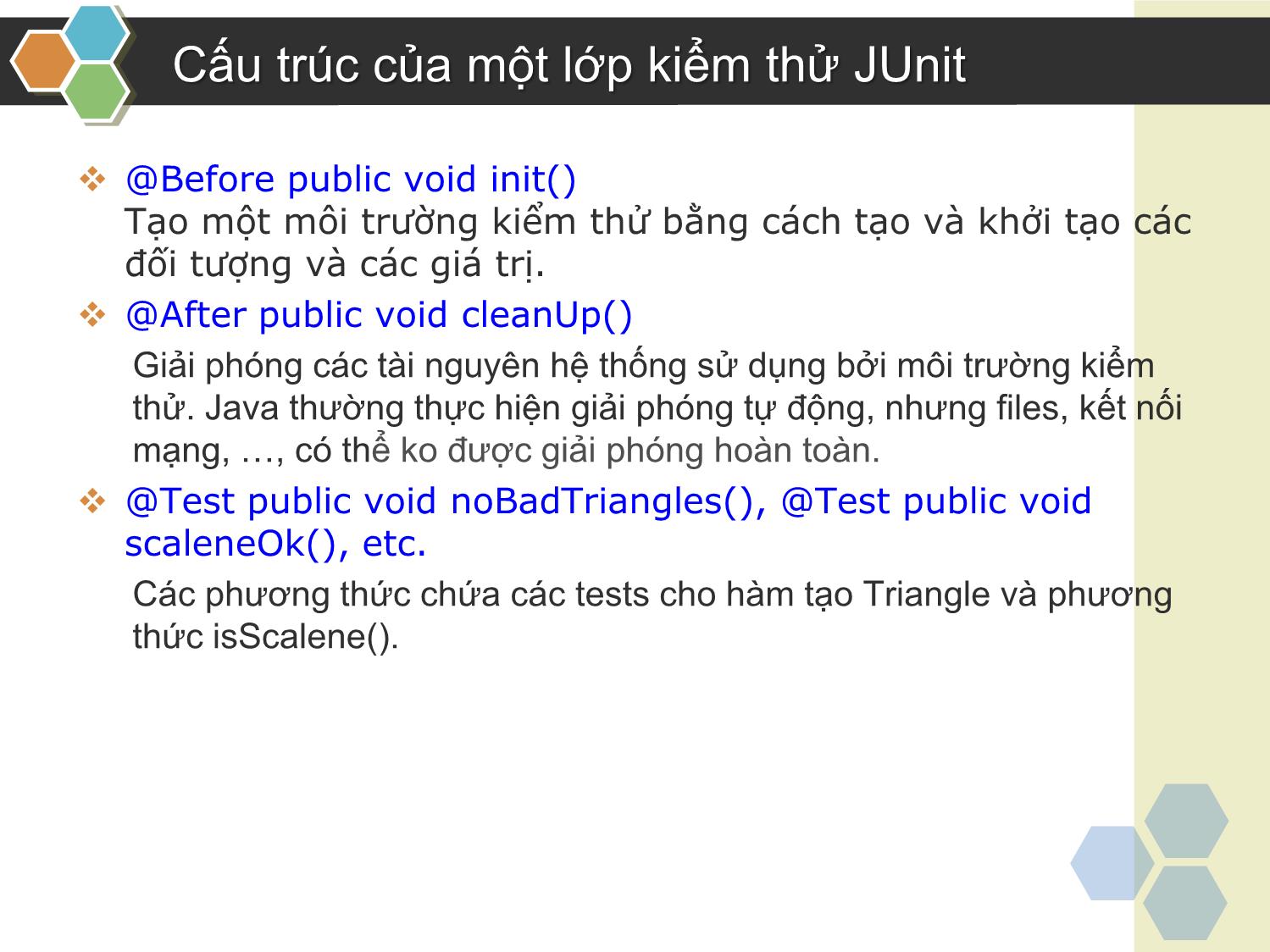
Trang 6
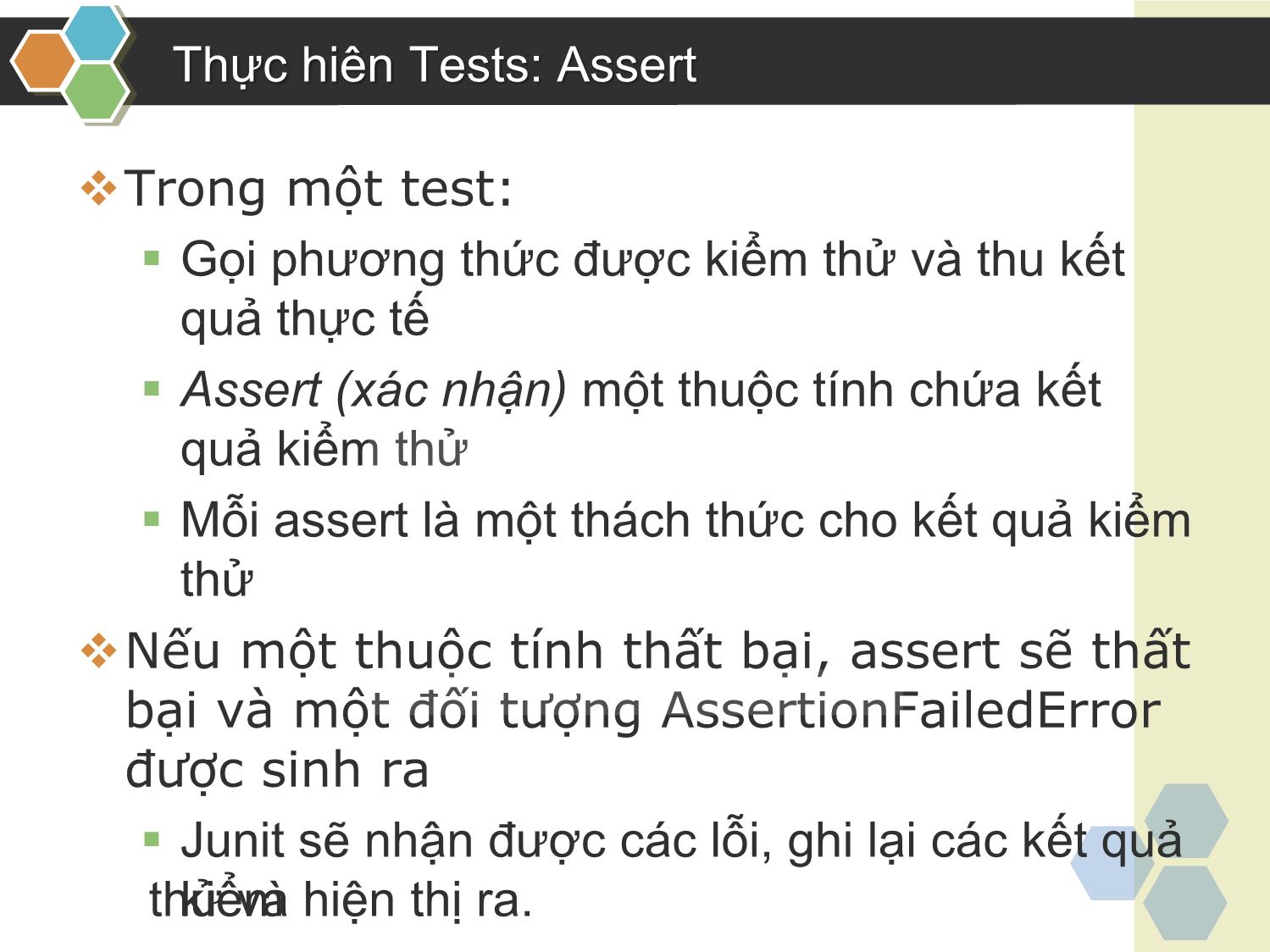
Trang 7
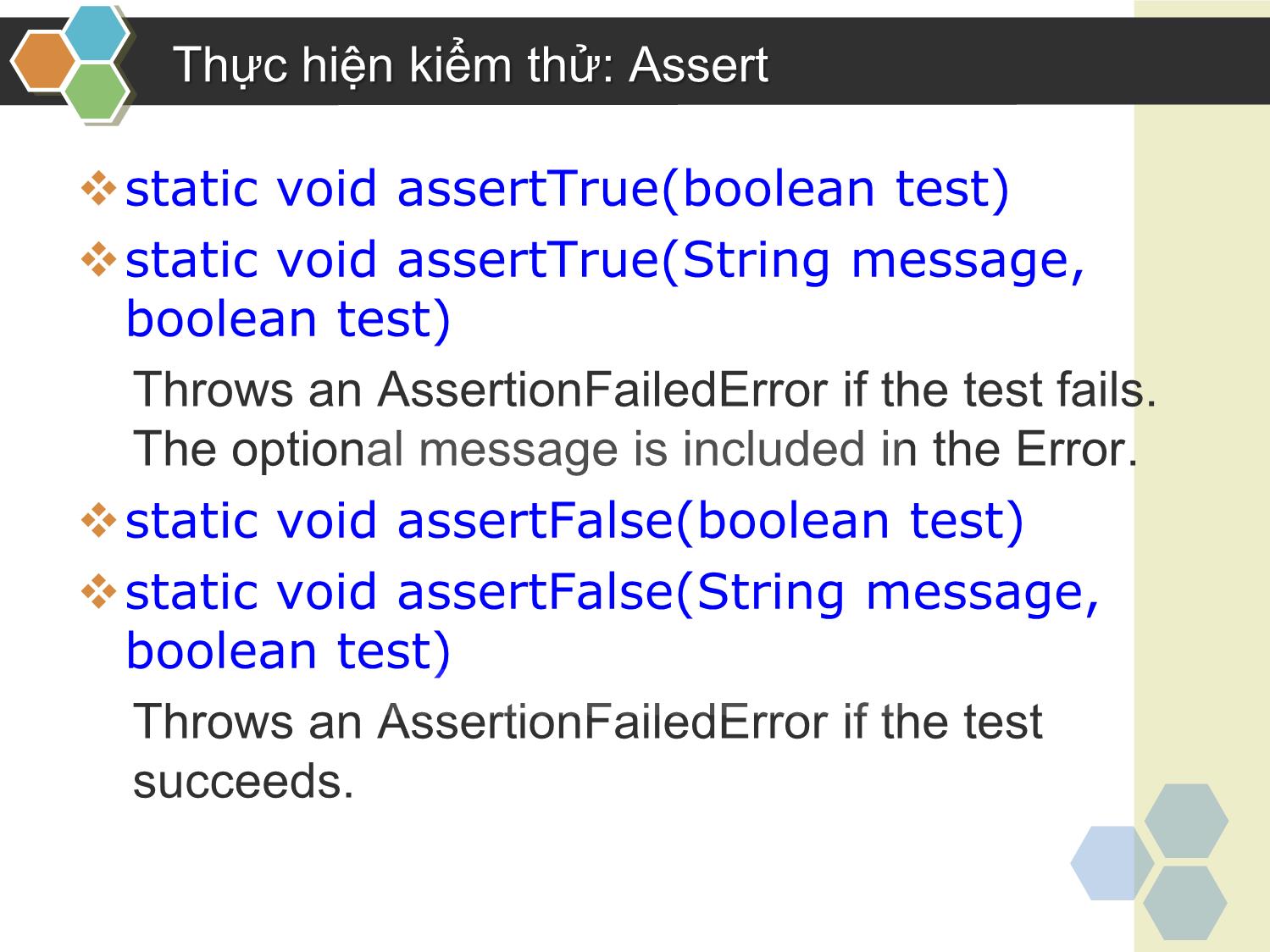
Trang 8
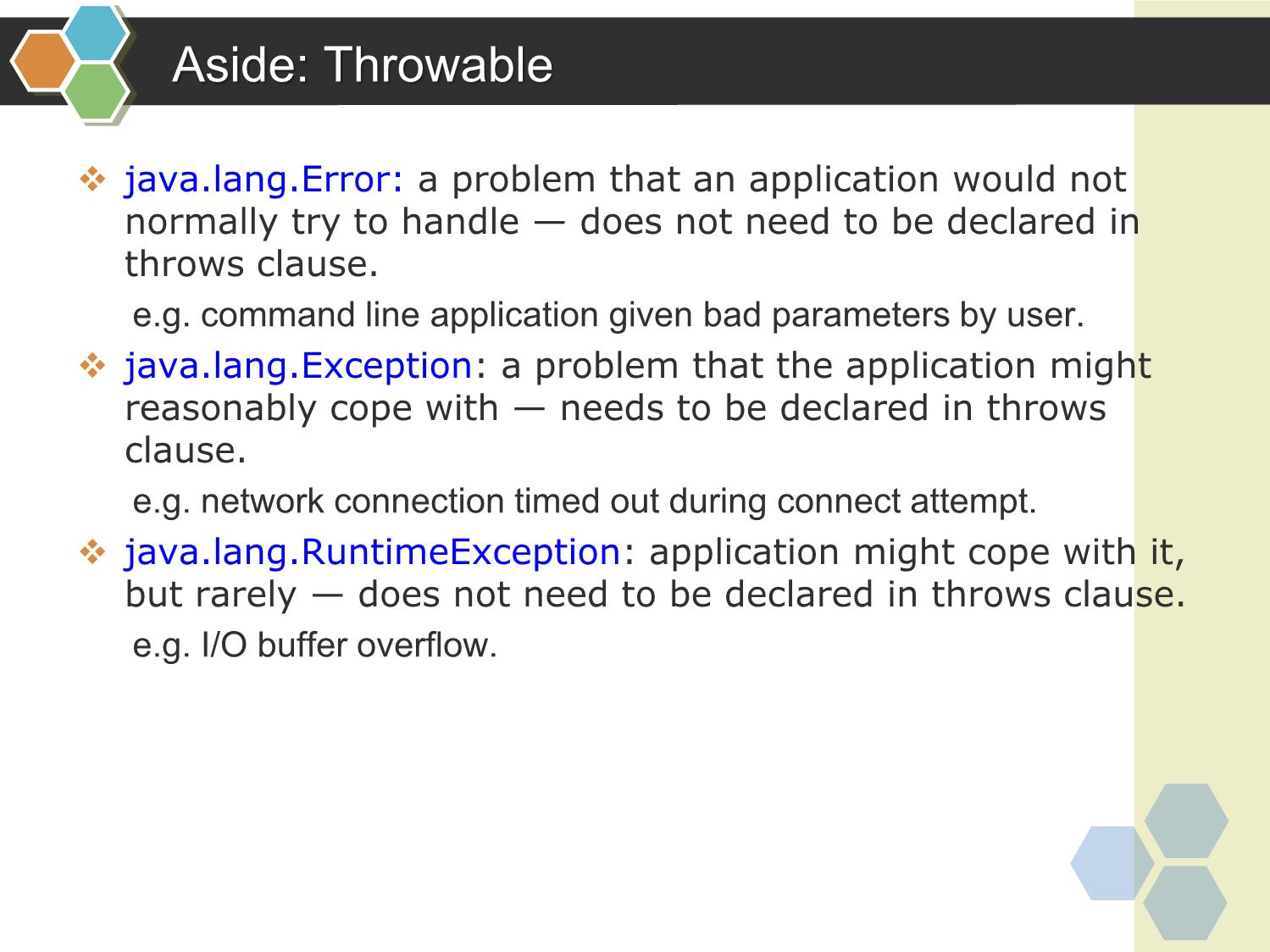
Trang 9
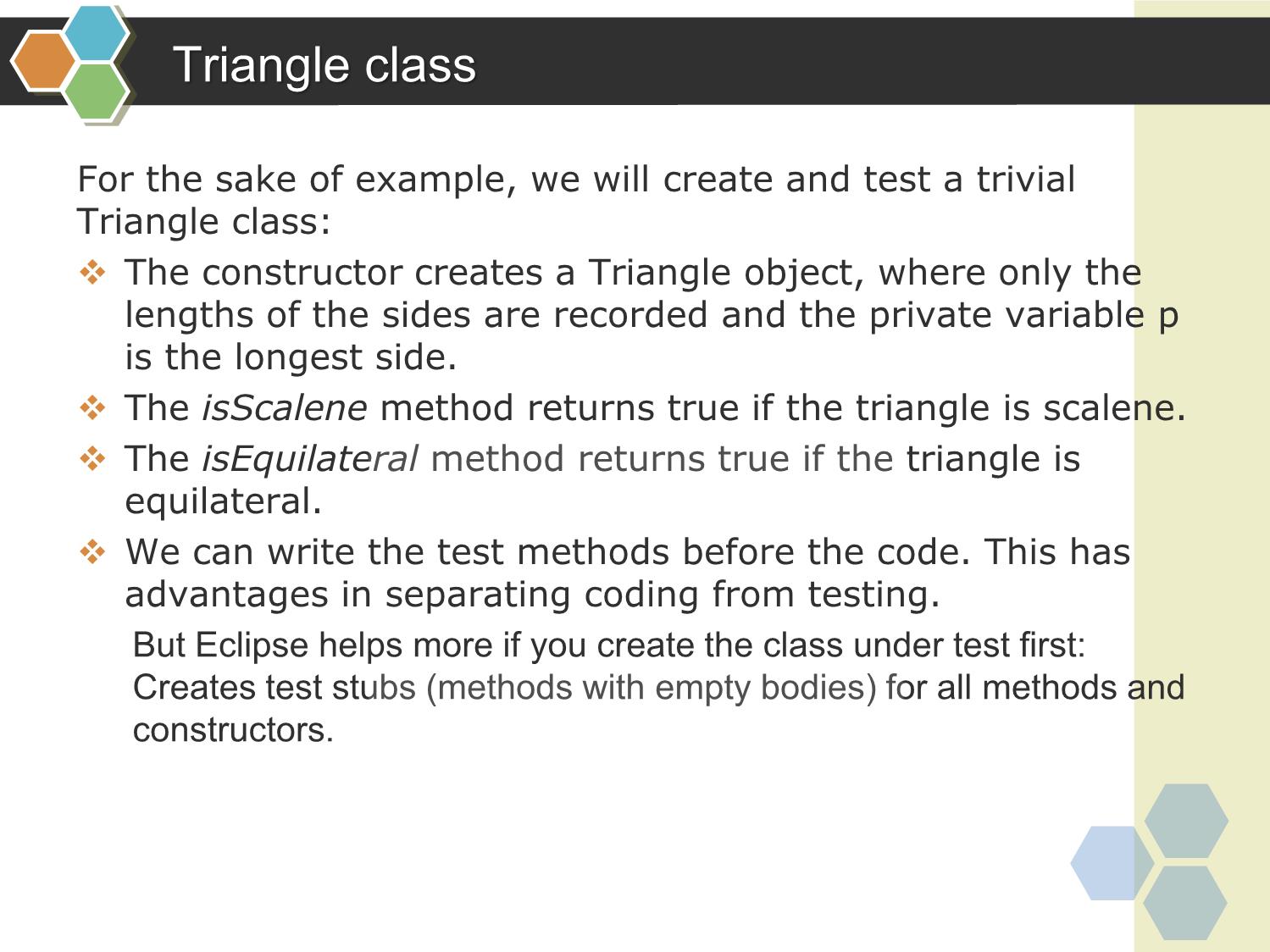
Trang 10
Tải về để xem bản đầy đủ
Tóm tắt nội dung tài liệu: Bài giảng Kiểm thử phần mềm - Chương 5: JUnit - Nguyễn Thanh Hùng

Trường Đại Học Bách Khoa Hà Nội
Viện Công Nghệ Thông Tin &Truyền Thông
Kiểm thử phần mềm
JUnit
TS. Nguyễn Thanh Hùng
Bộ Môn Công Nghệ Phần Mềm
Email: hungnt@soict.hust.edu.vn
Website:
JUnit
Junit là một nền tảng kiểm thử
- Viết bởi Erich Gamma (Design patterns) và Kent Bech
(eXtreme Programming)
- Sử dụng khả năng phản chiếu (Chương trình Java có thể
kiểm tra chính mã nguồn cuả nó)
- Cho phép:
- Định nghĩa và thực hiện kiểm thử và các tập kiểm thử
- Sử dụng test như một công cụ hiệu quả cho specification
- Hỗ trợ trên IDEs như BlueJ, Jbuilder, và Eclipse có tích hợp
sẵn Junit
- Website về Junit:
Các thuật ngữ về JUnit
―Test runner‖ là phần mềm chạy kiểm thử
và báo cáo kết quả
―Test suite‖ là một tập các trường hợp
kiểm thử
―Test case‖ kiểm tra phản ứng của một
hàm đơn với 1 tập đầu vào
―Unit test‖ là một kiểm thử của phần tử
mã nguồn nhỏ nhất có thể kiểm thử,
thường là một lớp đơn.
Các thuật ngữ về JUnit
―Test fixture‖ là môi trường chạy kiểm thử. Một môi trường
mới được cài đặt trước mỗi lần thực hiện trường hợp kiểm
thử, và được huỷ bỏ sau đó.
Ví dụ: để thử nghiệm một CSDL, môi trường kiểm thử có thể thiết
lập máy chủ ở trạng thái ban đầu chuẩn, sẵn sàng cho khách hàng
để kết nối.
―Integration test‖ là một kiểm thử cho việc kết hợp hoạt
động của nhiều lớp với nhau
Junit hỗ trợ một phần cho kiểm thử tích hợp
Cấu trúc của một lớp kiểm thử JUnit
Chúng ta muốn kiểm thử một lớp tên
Triangle
. Đây là kiểm thử đơn vị của lớp Triangle; định
nghĩa đối tượng sử dụng trong một hay nhiều
kiểm thử
public class TriangleTestJ4{
}
Đây là hàm tạo mặc định:
public TriangleTest(){}
Cấu trúc của một lớp kiểm thử JUnit
@Before public void init()
Tạo một môi trường kiểm thử bằng cách tạo và khởi tạo các
đối tượng và các giá trị.
@After public void cleanUp()
Giải phóng các tài nguyên hệ thống sử dụng bởi môi trường kiểm
thử. Java thường thực hiện giải phóng tự động, nhưng files, kết nối
mạng, , có thể ko được giải phóng hoàn toàn.
@Test public void noBadTriangles(), @Test public void
scaleneOk(), etc.
Các phương thức chứa các tests cho hàm tạo Triangle và phương
thức isScalene().
Thực hiên Tests: Assert
Trong một test:
. Gọi phương thức được kiểm thử và thu kết
quả thực tế
. Assert (xác nhận) một thuộc tính chứa kết
quả kiểm thử
. Mỗi assert là một thách thức cho kết quả kiểm
thử
Nếu một thuộc tính thất bại, assert sẽ thất
bại và một đối tượng AssertionFailedError
được sinh ra
. Junit sẽ nhận được các lỗi, ghi lại các kết quả
thửkiểmvà hiện thị ra.
Thực hiện kiểm thử: Assert
static void assertTrue(boolean test)
static void assertTrue(String message,
boolean test)
Throws an AssertionFailedError if the test fails.
The optional message is included in the Error.
static void assertFalse(boolean test)
static void assertFalse(String message,
boolean test)
Throws an AssertionFailedError if the test
succeeds.
Aside: Throwable
java.lang.Error: a problem that an application would not
normally try to handle — does not need to be declared in
throws clause.
e.g. command line application given bad parameters by user.
java.lang.Exception: a problem that the application might
reasonably cope with — needs to be declared in throws
clause.
e.g. network connection timed out during connect attempt.
java.lang.RuntimeException: application might cope with it,
but rarely — does not need to be declared in throws clause.
e.g. I/O buffer overflow.
Triangle class
For the sake of example, we will create and test a trivial
Triangle class:
The constructor creates a Triangle object, where only the
lengths of the sides are recorded and the private variable p
is the longest side.
The isScalene method returns true if the triangle is scalene.
The isEquilateral method returns true if the triangle is
equilateral.
We can write the test methods before the code. This has
advantages in separating coding from testing.
But Eclipse helps more if you create the class under test first:
Creates test stubs (methods with empty bodies) for all methods and
constructors.
Notes on creating tests
Size: Often the amount of (very routine) test code will
exceed the size of the code for small systems.
Complexity: Testing complex code can be a complex
business and the tests can get quite complex.
Effort: The effort taken in creating test code is repaid in
reduced development time, most particularly when we go
on to use the test subject in anger (i.e. real code).
Behaviour: Creating a test often helps clarify our ideas on
how a method should behave (particularly in exceptional
circumstances).
A Junit 3 test for Triangle
import junit.framework.TestCase;
public class TriangleTest extends TestCase {
private Triangle t;
// Any method named setUp will be executed before each test.
protected void setUp() {
t = new Triangle(5,4,3);
}
protected void tearDown() {} // tearDown will be executed afterwards
public void testIsScalene() { // All tests are named test[Something]
assertTrue(t.isScalene());
}
public void testIsEquilateral() {
assertFalse(t.isEquilateral());
}
}
A Junit 4 test for Triangle
The Triangle class itself
Is JUnit too much for small programs?
Not if you think it will reduce errors.
Tests on this scale of program often turn
up errors or omissions – construct the
tests working from the specification
Sometimes you can omit tests for some
particularly straightforward parts of the
system
The Triangle class itself
public class Triangle {
private int p; // Longest edge
private int q;
private int r;
public Triangle(int s1, int s2, int s3) {
if (s1>s2) {
p = s1; q = s2;
} else {
p = s2; q = s1; }
if (s3>p) {
r = p; p = s3;
} else {
r = s3;
}
}
public boolean isScalene() {
return ((r>0) && (q>0) && (p>0) && (pr) || (r>q)));
}
public boolean isEquilateral() {
return p == q && q == r;
}
}
Assert methods II
assertEquals(expected, actual)
assertEquals(String message, expected, actual)
This method is heavily overloaded: expected and actual must be both
objects or both of the same primitive type. For objects, uses your equals
method, if you have defined it properly, as public boolean equals(Object
o) — otherwise it uses ==
assertSame(Object expected, Object actual)
assertSame(String message, Object expected, Object actual)
Asserts that two objects refer to the same object (using ==)
assertNotSame(Objectexpected, Objectactual)
assertNotSame(String message, Object expected, Object actual)
Asserts that two objects do not refer to the same object
Assert methods III
assertNull(Object object)
assertNull(String message, Object object)
Asserts that the object is null
assertNotNull(Object object)
assertNotNull(String message, Objectobject)
Asserts that the object is null
fail()
fail(String message)
Causes the test to fail and throw an AssertionFailedError — Useful
as a result of a complex test, when the other assert methods are not
quite what you want
The assert statement in Java
Earlier versions of JUnit had an assert method instead of an
assertTrue method — The name had to be changed when
Java 1.4 introduced the assert statement
There are two forms of the assert statement:
. assert boolean_condition;
. assert boolean_condition: error_message;
Both forms throw an AssertionFailedError if the boolean condition is
false. The second form, with an explicit error message, is seldom
necessary.
The assert statement in Java
When to use an assert statement:
Use it to document a condition that you ‗know‘ to be true
Use assert false; in code that you ‗know‘ cannot be reached
(such as a default case in a switch statement)
Do not use assert to check whether parameters have legal
values, or other places where throwing an Exception is
more appropriate
Can be dangerous: customers are not impressed by a
library bombing out with an assertion failure.
Junit in Eclipse
Creating a Test
20
TemplateTem pforl atNewe Testfor New Test
Stuart Anderson Tools for Unit Test — JUnit c 2011
21
Running JUnitRunning JUnit
Stuart Anderson Tools for Unit Test — JUnit c 2011
Kết quả
Issues with Junit
JUnit has a model of calling methods and checking results
against the expected result. Issues are:
State: objects that have significant internal state (e.g.
collections with some additional structure) are harder to
test because it may take many method calls to get an
object into a state you want to test. Solutions:
. Write long tests that call some methods many times.
. Add additional methods in the interface to allow observation of
state (or make private variables public?)
. Add additional methods in the interface that allow the internal
state to be set to a particular value
. “Heisenbugs” can be an issue in these cases (changing the
observations changes what is observed).
Issues with Junit
Other effects, e.g. output can be hard to
capture correctly.
JUnit tests of GUIs are not particularly
helpful (recording gestures might be
helpful here?)
Positives
Using JUnit encourages a ‗testable‘ style, where the result
of a calling a method is easy to check against the
specification:
. Controlled use of state
. Additional observers of the state (testing interface)
. Additional components in results that ease checking
It is well integrated into a range of IDEs (e.g. Eclipse)
Tests are easy to define and apply in these environments.
JUnit encourages frequent testing during development —
e.g. XP (eXtreme Programming) ‗test as specification‘
JUnit tends to shape code to be easily testable.
JUnit supports a range of extensions that support
structured testing (e.g. coverage analysis) – we will see
some of these extensions later.
Another Framework for Testing
Framework for Integrated Test (FIT), by Ward Cunningham
(inventor of wiki)
Allows closed loop between customers and developers:
. Takes HTML tables of expected behaviour from customers or
spec.
. Turns those tables into test data: inputs, activities and assertions
regarding expected results.
. Runs the tests and produces tabular summaries of the test runs.
Only a few years old, but lots of people seem to like it —
various practitioners seem to think it is revolutionary.File đính kèm:
 bai_giang_kiem_thu_phan_mem_chuong_5_junit_nguyen_thanh_hung.pdf
bai_giang_kiem_thu_phan_mem_chuong_5_junit_nguyen_thanh_hung.pdf

